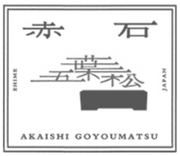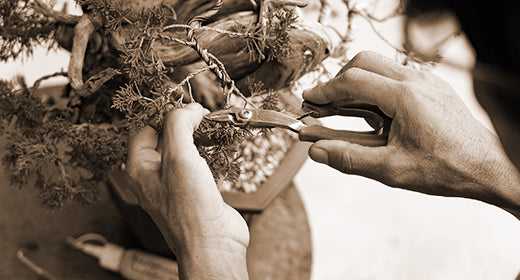-
Explanation of the characteristics of Akaishi Goyomatsu, Japan's premier bonsai brand, and how to obtain it
Japanese bonsai is appreciated and exported all over the world for its high craftsmanship. Even if we say "Japanese bonsai" in one word, there are various production areas in Japan and craftsmen with techniques that have been passed down from generation to generation in those areas.
On this site, I will introduce the appeal of Akaishi Goyomatsu, which is of the highest quality and value in Japan and has won awards in many competitions, and how to purchase it, and how you can get a real Japanese bonsai without coming to Japan.

From a Japanese farmer to you, overseas
We are a group of Japanese producers who run this site. There are several bonsai growing areas in Japan, and here in Shikokuchuo, Ehime Prefecture, is one of the pine bonsai growing areas.
Shikokuchuo City in Ehime Prefecture is one of the production areas of pine bonsai. The city has been attracting attention in recent years as the site of the Setouchi International Art Festival, which was selected as the seventh of "52 Places to Go in 2019" by The Guardian and The New York Times.
The Setouchi region is blessed with a granitic sandy loam soil with good drainage, little rainfall, and long hours of sunshine, which makes it possible to produce bonsai with a character not found in other regions.
Akaishi Goyomatsu" is a brand of bonsai that was created by protecting the original species of Goyomatsu that has been growing naturally in this area since ancient times.

Is this Japanese bonsai authentic?
Japanese bonsai is exported all over the world and you can get it in your country. But is the bonsai a real Japanese bonsai?
Until now, there were no Japanese bonsai stores abroad. The bonsai sold overseas are bought by bonsai dealers in the country and sold in their own country.
Exporting bonsai is a very hard job that requires passing strict quarantine and conditions. Therefore, before Japanese bonsai can be sold in stores in your country, it may have to go through a number of companies, including primary and secondary wholesalers.
In this process, fake bonsai may be distributed as Japanese bonsai. In the end, there is no guarantee that the Japanese bonsai at the store is authentic.
Because of the high brand value of Japanese bonsai, Japanese growers are concerned that there are many fake bonsai on the market that are falsely claimed to be from Japan.
Therefore, with the cooperation of our local partners, we decided to establish a Japan-based bonsai company in order to deliver authentic Japanese bonsai to overseas markets.
We will establish a system to certify the production and distribution records in Japan, so that only high quality bonsai approved by Japan can be distributed in the market.
You will be able to get authentic bonsai at affordable prices because of direct sales by Japanese producers.
If you are interested in Akaishi Goyomatsu and would like to consider getting one, the transaction process is explained on this page. First, let me guide you through the appeal and value of Akaishi Goyomatsu.
Goyomatsu, a bonsai species that enjoys overwhelming popularity in Japan

There are two main areas in Japan: the southern area (Southern Goyomatsu) and the northern area (Northern Goyomatsu). The southern area is found in the Shikoku and Chugoku regions, while the northern area is mainly native to the Tohoku region.
The southern Goyomatsu has light green foliage with short, slightly open leaflets and a soft texture, while the northern Goyomatsu has dark green foliage with slightly longer, twisted leaves and a distinctive white stripe on the underside of the leaf. Within the two series, southern and northern, there are further differences in foliage and bark depending on the native habitat.
There are three well known types of Goyomatsu in Japan: Shikoku Goyo (famous for its Shikoku region), Nasu Goyo (found mainly in the Nasu Mountains), and Azuma Goyo (found in the Azuma mountain range in Fukushima Prefecture).
From the Meiji era to the Taisho era and the early Showa era, the mountains of Shikoku have provided the bonsai world with many excellent materials. In the mountains of Shikoku and in the subalpine zone of the Ishizuchi mountain range, which is the highest mountain in western Japan, the five-leaf pine trees are collectively called Shikoku Goyomatsu. There are two main types, the Akaishi and Ishizuchi mountain ranges. The Akaishi and Ishizuchi series can be divided into two main groups: the Akaishi and Ishizuchi.
The leaves of the Akaishi series are thicker and less fragrant than those of the Ishizuchi series, which is designated as a natural monument by Ehime Prefecture, while the leaves of the Ishizuchi series are softer and more feminine.
In the past, overharvesting occurred, The Akaishi Goyomatsu Bonsai Association is responsible for the systematic collection of the species by licensed local seed collectors and the thorough selection and cultivation of the material.
The old-growth forest of Goyomatsu still exists today, and it is the fruit of the passionate efforts of our ancestors to protect the material and regenerate it into bonsai.
The Treasure of Japanese Bonsai, Akaishi Goyomatsu

There are various types of Japanese Goyomatsu, but Shikoku Goyomatsu, especially Akaishi Goyomatsu produced in Shikokuchuo City, Ehime Prefecture, is of exceptional value and is called the "Queen of Bonsai".
Akaishi Goyomatsu are made to look as natural as possible, without unnatural bends or trunk patterns, and are made into bonsai trees. You can feel the majestic nature of the tree without feeling that human hands have been involved.
The graceful form that embodies the softness and suppleness of a woman is truly that of a queen.
The craftsmen were determined to preserve the original species of Akaishi Goyomatsu in the Akaishi Mountains, where it grows naturally, and did not use grafting or cuttings, but instead continued to harvest young trees and produce them from seeds.
Over a period of many years, craftsmen have succeeded in producing this product from generation to generation.
Characteristics of Akaishi Goyomatsu
・Foliage is bright green
・The silver line on the underside of the leaves is dark
・It grows well packed
・The trunk surface has a tendency to show its age early
・Very good bud break
・Beautiful shape
Our thoughts

We want to bring the landscape of Japan to everyone. We want to preserve our landscape for the future. In our hometown of Doi-cho, located in Shikokuchuo City, Ehime Prefecture, there is a Japanese landscape that is being lost to the modern world.
It is a primeval forest of Goyomatsu trees that have grown wild since ancient times on Akaishi Mountain facing the Seto Inland Sea. It is also designated as a natural monument. The Akaishi Goyomatsu tree has watched over Japan for a thousand years. We want to preserve it for the future.
What we bonsai craftsmen can do is to continue to create this natural scene of Akaishi Mountain through the bonsai of Goyomatsu.
As bonsai craftsmen, we want to continue to protect what is important so that the Japanese landscape will not be lost. That is the mission of bonsai and our job.
Japan's top class craftsmen group

The town of Doi in Shikokuchuo City, Ehime Prefecture, has flourished as a bonsai production center since ancient times, and tens of thousands of bonsai trees are still planted and produced there.
The craftsmen who have been producing bonsai for generations are working hard every day to produce Akaishi Goyomatsu.
Many enthusiasts and foreigners come to this area to learn the art of bonsai.
There are many different types of craftsmen: some give demonstrations all over the world, some focus on teaching bonsai techniques, some win top prizes in domestic bonsai competitions, and some develop new species and research new production techniques.
They all have their own specialties and techniques, and the bonsai they produce reflect their individuality. For bonsai lovers, the ability to find a bonsai that matches their image depends on whether or not they can find a good craftsman or producer, so it is a good idea to gather information and talk to many craftsmen by foot.
Some craftsmen are traditional and continue to produce dignified bonsai, while others pursue artistry and try to create bonsai that evolve with new things. They all like to talk, so please feel free to talk to them. If you get to know them, they may be able to help you create your own bonsai.
About Akaishi Goyomatsu Production Area

The production area of Akaishi Goyomatsu is located in the middle of Shikoku, one of the islands that make up the Japanese archipelago. Facing the Seto Inland Sea, there are several pine bonsai production areas in this area, and the neighboring Takamatsu Bonsai is also a world famous production area. If you have a chance to visit this area, you will be able to spend your days immersed in bonsai. There are 40 growers in the Akaishi Goyomatsu region.
How to get a high quality Japanese bonsai Akaishi Goyomatsu
If you live in a European country, it is easy. There is a bonsai management center in Frankfurt, Germany, run by a Japanese producers' association.
They send hundreds of carefully selected bonsai from Japan every year and you can see the actual bonsai in Germany. If you like a bonsai, you can trade it and buy it on the spot.
If you can't make it to Germany, don't worry. Bonsai maintained in Germany can be viewed on the Internet, and if you find a bonsai you like, you can order it and it will be delivered by land from Germany if you are in Europe.
Bonsai maintained in Japan can also be viewed on the Internet and can be delivered from Japan via Germany if ordered.
All of the bonsai are genuine Japanese bonsai sent directly from the production area in Japan. There are no fake bonsai. You can come to Frankfurt, Germany, to see the bonsai for yourself.
If you come to Frankfurt, Germany, you will be able to meet real Japanese bonsai.
Export system
We send only high quality Japanese bonsai to Germany after passing the strict screening.
 The bonsai are packed and shipped from Japan by experienced people who take the utmost care to ensure that the bonsai are not damaged.
The bonsai are packed and shipped from Japan by experienced people who take the utmost care to ensure that the bonsai are not damaged. 
Certification of high quality
Each bonsai comes with a certificate. Each bonsai exported from Japan is issued a certificate as proof of quality by the Japanese bonsai management organization.

The certificate on each bonsai contains a record of the bonsai, information about the producer, and information about the movement of the bonsai. It is controlled by an individual number, so when you give away your bonsai, it will not lose its value as proof of authenticity.



